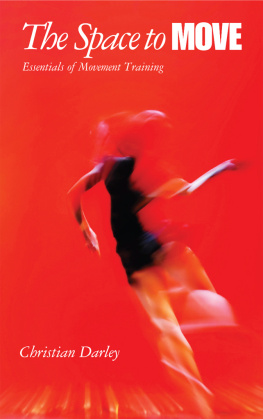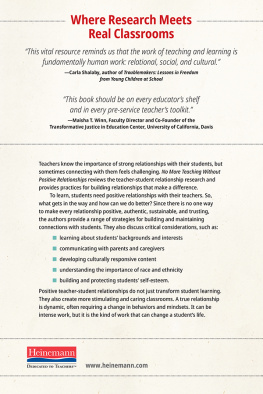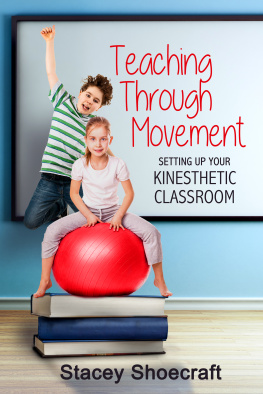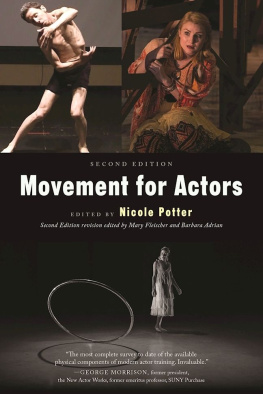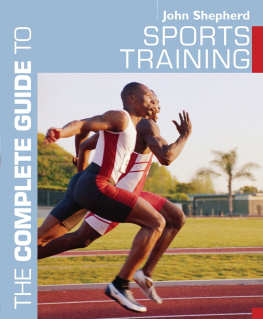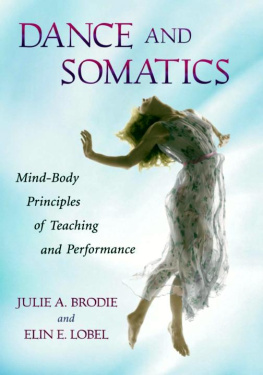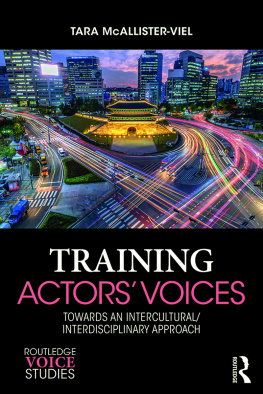The Space toMOVE
Essentials of Movement Training
Christian Darley
Edited by Linda Baker, Dictynna Hood and Sue Mitchell

NICK HERN BOOKS
London
www.nickhernbooks.co.uk
For Dictynna Hood
Publishers Note
I had just read the first draft of this book when news came that Christian Darley had died. The book has been prepared for publication by three of her friends and colleagues, named as editors on the title page. I am extremely grateful to themand have enjoyed working with them.
Nick Hern
Editors Note
Christian was frustrated that she was unable to teach any more because of illness, so Dictynna Hood, with whom Christian often collaborated, suggested that she write a book about her teaching.
The book took shape over the period of two years from 2004: at first as a series of responses that Christian wrote longhand to questions faxed or sent to her by Dictynna. The book was then typed up by Daphne Mitchell.
A couple of months before she died in 2008, Christian invited Sue Mitchell, Linda Baker and Dictynna to edit The Space to Move for her. Sue trained with Decroux in Paris. Linda has taught drama for thirty-eight years. Dictynna is a director. Like Christian, Dictynna studied Classics and has collaborated with her on three Greek plays.
Peter James, Head of LAMDA, approached Nick Hern with the typescript.

As editors, we have changed some of the ordering of the book to make it flow more clearly, and we have adapted some chapter headings. We are delighted that Christian was able to write this wonderful book, and that her work can now leap off the page and continue to inspire others as it has inspired us.
Christian had a rare insight that her chosen editors would work and play well togetherand we have!
Linda Baker, Dictynna Hood and Sue Mitchell
Beginnings
John Bartons Henry V at Stratford in 1971 when I was nine. Sitting down in the auditorium, people chatting, actors wandering about onstage, casually choosing casual costumes off rails and slowly pushing the rails to clear an empty space. Spectators carry on talking. Why are the actors dressing onstage? I felt I was prying, but also rather enjoying young men with nice legs changing their trousers. Suddenly an actor finishes buttoning his shirt and walksa totally different walkinto the space. Lights change. Transformation! Theatre with the snap of the fingers, but also a walk.
When I was eleven I gave up ballet. Id done Grade 4 and wasnt going to be a ballet dancer. Thanks to growing up in a college with plenty of spacious rooms, I would put on the tape recorder and dance whenever I could. It was a drug. But I loved to play and was drawn more and more to theatre and the grandeur of opera. At seventeen, I saw Les Enfants du Paradis, and this classic French film made sense of everything I was interested in. Jean-Louis Barraults sublime playing of the mime Deburau, Baptiste in the film, woke me up to the vast possibilities of movement for an actor, before the actor even utters a word onstage. So I went to Paris, and under the terrifying eye of Ella Jaroszewicz of the Tomaszewski Pantomime Theatre, studied Pantomime Blanche and illusionary mime. Ella, tough as old boots, worked us like dogs until we could dismiss the technique and play. Then she became beautiful. I returned to England and university, in love with Paris, in love with mime, but acutely aware Id only touched on a vast world that moved.
Introduction
This is a book for actors, directors, students and teachers. It is for anyone interested in looking at what it means to have the space to move, and how that space to move directly affects the way an individual actor or group performs, be it on the stage or in the studio or in the classroom, or anywhere else. This is not a textbook or a list of exercises, nor is it an academic exposition of movement techniques. It is a look at the process of movement training as it happens on the floor and how that process is a process of play.
I like to imagine that process as something akin to the inflation of an enormous balloon: from the half-hour before the curtain goes up, for example, until the last curtain call, a balloon has slowly been inflated by every member of the company. The balloon, fully inflated, will take off, not necessarily in the direction expected, but nevertheless it will take off. The process of a rehearsal or workshop also has this balloon-like quality. That is the ideal. But there are good shows and bad shows, good rehearsals and bad, when the darned balloon doesnt have a chance of inflating: X didnt show up, Y doesnt do company warm-ups, there are no company warm-ups, Z was late, the actors are out of sorts, there was a bad review, the studio is gloomy, and cold Hundreds of reasons or just a few, but each is a little pin slow-puncturing the balloon. It cannot take off. There is no movement into a new space, the play space where things happen.
Over the years the greater part of my work as a movement director has been concentrated on what makes a rehearsal work, what allows an actor to transform totally, what is the process happening in a company when the balloon lifts off actually, what is a company for that matter? After taking a long look at my work in professional theatre, my teaching work at LAMDA and my work with individuals outside the profession, my odd successes and dreadful failures, I realise that the answers lie in the creation of an atmosphere: an atmosphere in which extraordinary work can evolve. My job was to promote that atmosphere by recognising the need for space in both the actor and the group that he or she is part of, space in which to be fully present in order to work; in this business, that means the space to play.
Movement Training
Both inside and outside the acting profession there has been a tendency to see movement as an extra (Oh, we dont need any movement in this show), something you can be good or bad at (Can I sit this one out, Christian, Im no good at movement?). Today, theatre schools understand the vital role of movement in actor training, yet movement, pure movement, movement for actors can still remain an elusive business, even with the straightforward mastery of movement as a common goal. This is simply because movement is not a set discipline as in ballet or in fight. There is no laid-down technique called movement, and thank heavens for that! How can there be a technique set in stone for both Maia, a professional ballet dancer for five years who now wishes to become an actor, and for Tom, slightly overweight, who arrives at drama school with a horror of anything physical?
The directors and teachers of movement in the theatre world come from many different backgrounds, from ballet to Decroux, Laban, Lecoq and Grotowski to name a few, and we adapt and turn our training inside out to meet the needs of the actor in front of us. As a result, the business of movement training is constantly growing and developing in its common, fundamental purpose: enabling the actors before us to play, and to play well. Most of us movement directors are, or have been, performers, and this bringing of bodies together to play is what unites and identifies us.
A Note on Words
In this book I have used certain words again and again: awareness, noticing, listening and musicality, words often used by practitioners like myself. These words explain a process: when we explore them, we can begin to feel the flesh, the physical activity whence they get their meaning. The French word,
Next page
